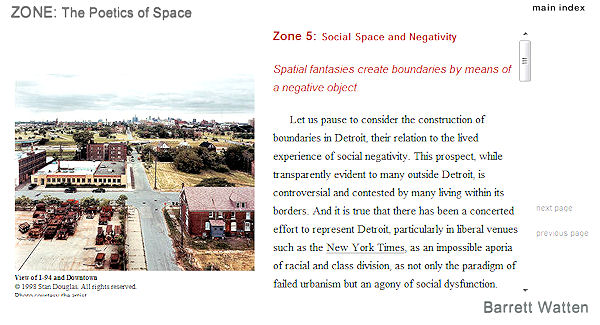Mark(s), the Detroit-based, multigenre, poetry/art webzine, has concluded its ten-year run by putting up a remediated archive of the work it curated and published: www.markszine.net. Mark(s) was notable for developing a transformative digital aesthetics that worked between word and image, always attentive to the ways the developing display, linking, and animation possibilities of the medium could reinterpret the work. Designer Deb King accomplished this spectacularly in one of my own contributions, “Question of Interpretation”:
The work was a series of twelve four-line serial poems, each highly subjective in their content and interpretation, introduced by a “Rorschach” inkblot image made by the author about age 12. I had preserved these icons only to discover them, and their proper use, decades later. Mark(s) also published a word-image collaboration with Canadian photographer Stan Douglas, who made a series of “negative” landscape portraits that were controversial in Detroit—the view of a cultural outsider, it was said—and could only be seen across the Detroit River at the Art Gallery of Windsor, where curator Helga Pakasaar curated their exhibition and invited me to lecture. I produced “Zone: The Poetics of Space” and read it in the gallery, surrounded by Douglas’s works; the essay appears as the final chapter of The Constructivist Moment:
. Link
Link
In thanking Deb King and Ted Pearson, her coeditor, for the gorgeous job they did with Mark(s), and the always edgy and exploratory assemblage of writing and art they created, I also note the cultural irony of its site of production. While their project could only have been produced in Detroit, it was scarcely understood or recognized there. In spite of the quality of the work, or even because of it, the digital publication of Mark(s) did nothing to change the cultural landscape of Detroit—which continues to be guided by the same agonized assumptions of the romantic, alienated, marginalized aporia it has fantasized itself as since Day One.*
*A friend asks what is meant by “Day One” above. It could be a variation on Ford’s old advertising slogan “Quality is Job One,” or of my line from Under Erasure: “It is day one, / or a design problem.” But I think “Day One” primarily refers to the day one arrives in Detroit, from which point onward, things pretty much remain the same (even as Detroit has externally changed in many ways). A negative “cultural logic” of the aesthetic persists, no matter how many world-class innovations (Motown, Iggy Pop, techno, noise) may arise here.













